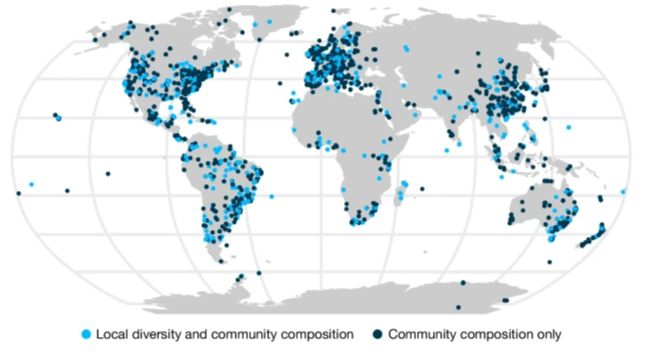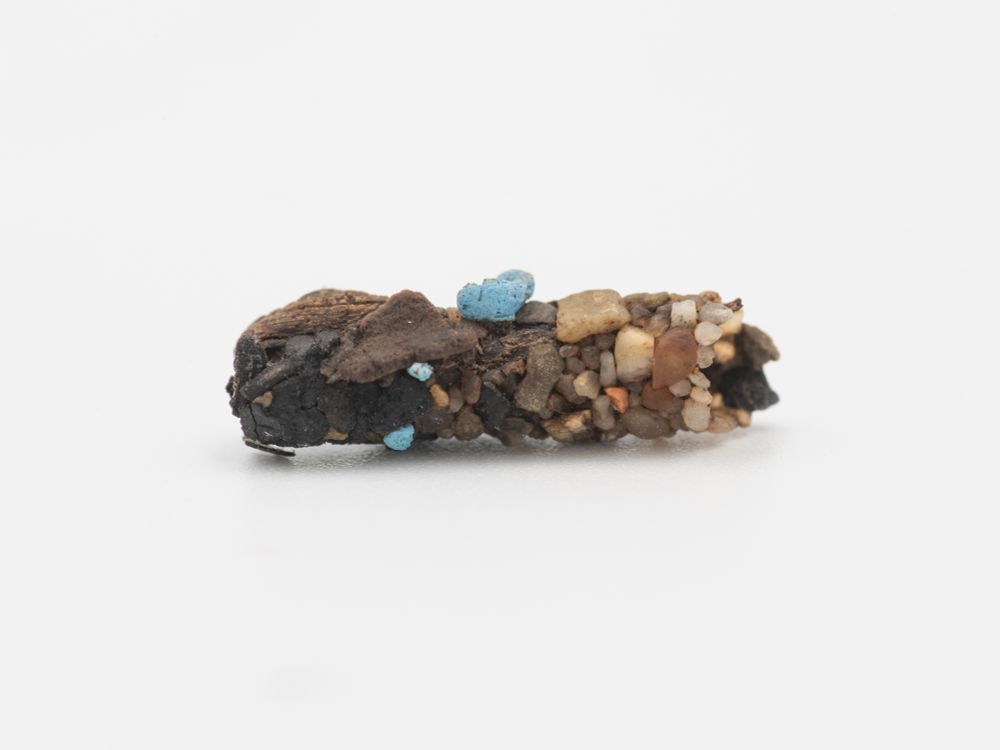A cool way to look at size spectrum!
30.04.2025 01:43 — 👍 1 🔁 0 💬 0 📌 0

Cereghetti et al: #Seasonal #dynamics of detritus flows and #decomposition across #ecosystem boundaries.
🌿🍂🦐 🌐🌍
We studied seasonal dynamics/phenology ⏱️ of 🟩terrestrial-🟦aquatic linkages across a year: www.sciencedirect.com/science/arti...
Out in #CurrentBiology @currentbiology.bsky.social
1/4
12.04.2025 10:33 — 👍 20 🔁 10 💬 1 📌 1

World map showing origin of the data
Our study ‘The global human impact on biodiversity’ is out in Nature!
Through an unprecedented synthesis (2133 studies!) we show that humans are not only shrinking species numbers—but reshaping entire communities across the planet. 🌍🌐🐟🌿🪲
www.nature.com/articles/s41...
26.03.2025 16:31 — 👍 170 🔁 77 💬 3 📌 5
Other taxa identified with low dispersal capacity will be more sensitive to longitudinal connectivity in the watershed. Therefore, we echo the recent call on the importance of considering both cross-ecosystem (lateral) and longitudinal connectivity as targets for conservation planning.
10.04.2025 13:43 — 👍 0 🔁 0 💬 0 📌 0
bottom-line 1: Despite nuances and a call for further investigations, those results suggest that shredders and predators could be key transmission belts in the propagation of cross-ecosystem perturbations because of their strong associations with variations in terrestrial subsidy quality.
10.04.2025 13:43 — 👍 0 🔁 0 💬 1 📌 0
b) dispersal traits: Taxa with high dispersal capacity were more abundant in lakes with lower connectivity compared to taxa with low dispersal capacity. BUT no associations with resource quality! Thus no site selection based on resource quality, whether directly or by proxy.
10.04.2025 13:43 — 👍 0 🔁 0 💬 1 📌 0
a) feeding traits: we were surprised that predators (R2=0.5) association with quality (t-POM phosphorus) was much stronger than shredders (R2=0.01). But then, predators are prone to stoichiometric imbalance, and shredders might be limited by other metrics of quality (fungal biomass, toughness etc.).
10.04.2025 13:43 — 👍 0 🔁 0 💬 1 📌 0
Identifying key traits associated with cross-ecosystem resource inputs is an essential step toward developing a general understanding of how perturbations can propagate across ecosystems. We thought a) feeding traits and b) capacity to move and track resource quality were good starting points.
10.04.2025 13:43 — 👍 0 🔁 0 💬 1 📌 0
Response of freshwater macroinvertebrate feeding and dispersal traits to variations in terrestrial detritus quality
Can semi-aquatic insects track the quality of terrestrial subsidy ? We found that predators responded the most, followed by shredders. Dispersal traits did not respond at all. In brief, predators and shredders are transmission belts of cross-ecosystem perturbations (see 🧵for more). 🧪💧🌎
rdcu.be/eg7RT
10.04.2025 13:43 — 👍 4 🔁 5 💬 1 📌 0

Lead author Auke-Florian Hiemstra holds the oldest known caddisfly casing containing microplastic, dating to 1971. Photo: Liselotte Rambonnet.

A caddisfly casing with pieces of blue microplastic, dating 1986. Photo: Auke-Florian Hiemstra
NEW PAPER, JUST OUT! 👀
Insects from the '70s and '80s were already collecting microplastic, decades before the term microplastic even existed. 🤯
A thread on the surprising history of this pollutant and the incredible insect larvae that helped us uncover it. 🐛
Let's dive in! 🧵👇 1/x
09.04.2025 10:06 — 👍 1514 🔁 702 💬 33 📌 120
3. Main local drivers of prevalence mainly involved abiotic factors but most interestingly to me we found strong evidence for a biotic dilution effect (community with more none-host species tend to have some protecting effects on host species). To know more - look at the paper - :-)
01.04.2025 13:32 — 👍 0 🔁 0 💬 0 📌 0
....to the fact that they interact with fish "personality" and movement range and thus they overall simply sample different parts of the community (and location in the waterbody). Interestingly though, in terms of prevalence estimation, they tend to converge with sampling effort to similar values!👇
01.04.2025 13:32 — 👍 1 🔁 0 💬 1 📌 0
Main findings are: 1. Because of spatial aggregation in infection prevalence, small sampling effort led to an important overestimation of prevalence. Fortunately the threshold to reach a good estimate is not very high. 2. Fishing methods do influence results owing probably...👇
01.04.2025 13:32 — 👍 1 🔁 0 💬 1 📌 0
Un super projet multimédia dirigés par deux étudiants du labo pour mettre de l'avant la recherche ainsi que les chercheur_es en écologie des eaux douce au Québec (A great multimedia project led by two of our lab students to showcase Quebec research and researchers in freshwater ecology) 💧
23.01.2025 18:53 — 👍 4 🔁 0 💬 0 📌 0

Interested in multiple stressor research in rivers?
Interested in a PhD under excellent supervision in one of Europe’s largest freshwater research centres?
We seek 8 doctoral researchers for the CRC RESIST at the University of Duisburg-Essen!
sfb-resist.de/people/open-...
#rivers #PhDjobs
19.12.2024 16:33 — 👍 25 🔁 28 💬 0 📌 3
Important : an english version of the ad will be posted very soon !
17.12.2024 14:50 — 👍 1 🔁 0 💬 0 📌 0
*Job Hiring*: If you speak french or are willing to learn, my Env. Sci. dept. at UQTR is currently hiring in the field of geospatial sciences applied to the environment. Come and work with us where you can ski from your office while still being close to major cities.
tinyurl.com/37wayhhz
#geosky 🧪
17.12.2024 14:37 — 👍 4 🔁 3 💬 1 📌 1
“Experts and scientists are migrating to Bluesky in record numbers.” Welcome if you’re new (and if you’re not, please help by reposting) - here’s a starter pack for the #biodiversity science-policy community:
go.bsky.app/LjV86zg
24.11.2024 18:18 — 👍 373 🔁 182 💬 38 📌 7
Would love to join if possible thanks
26.11.2024 00:30 — 👍 0 🔁 0 💬 0 📌 0

Continental-scale nutrient and contaminant delivery by Pacific salmon - Nature
Pacific salmon transport of nutrients and contaminants to freshwaters increased by 30% and 20%, respectively, between 1976 and 2015, an increase dominated by pink salmon, which had the highest nu...
Salmon are an archetypal spatial subsidy transporting marine-derived nutrients and contaminants to inland freshwater and terrestrial food webs. When considering past and present ecosystems in Aotearoa, we should appreciate the role of diadromy in connecting multiple ecosystems #metaecosystems
24.11.2024 02:17 — 👍 14 🔁 4 💬 1 📌 1
Merci Nicolas - must admit I have no clue how those starter package works - but happy to be on the list :-) - thanks!
19.11.2024 14:17 — 👍 2 🔁 0 💬 1 📌 0
Merci Julie !...this was a true "slow-science" project that started in 2017 following a discussion with Shawn Leroux, and it would have never seen the day without stellar works from Anne McLeod...was well worth the wait ! ;-)
18.11.2024 21:19 — 👍 1 🔁 0 💬 1 📌 0
...identifying those processes is essential to an efficient identification of conservation/restoration targets. For instance If the main driver is animal-vectored, than connectivity might become an important management aspect, or the local maintaining of trophic interactions (etc.). End - thanks !
18.11.2024 19:56 — 👍 1 🔁 0 💬 0 📌 0
4 - More speculative - but we offer insights on how the spatial scaling of elemental distribution can inform the underlying processes - are the patterns driven by geological processes or biotic processes (organisms moving nutrients in the landscape, trophic interactions). More test needed here...
18.11.2024 19:56 — 👍 0 🔁 0 💬 1 📌 0
Maintaining an heterogeneous mosaic is essential in the context where conservation management moves more toward multi-function landscapes. Our work also emphasizes the notion of geodiversity which encompass the diversity of both biotic and abiotic ecosystem components (and their interactions).
18.11.2024 19:56 — 👍 0 🔁 0 💬 1 📌 0
Thus, we assume in our work that being unique makes you a stronger contributor to diversity at landscape-scale. In a landscape dominated by few elements (agricultural matrix), the habitats with high calcium or magnesium (or else) are the ones we should prioritize to maintain a mosaic.
18.11.2024 19:56 — 👍 0 🔁 0 💬 1 📌 0
3- Apply statistical tools to extract spatial patterns in elemental turnover. Here we suggest using tools from community ecology such as LCBD and SCBD to identify sites and elements that contribute most to the observed spatial turnover. Those represents your hotspots/coldspots
18.11.2024 19:56 — 👍 0 🔁 0 💬 1 📌 0
Postdoctoral Research Fellow @mcgill.ca interested in the mysterious underwater acoustic world of lakes & ponds.
#ecoacoustics #freshwaterecology
Web: https://www.jack-greenhalgh.com Scholar: https://scholar.google.co.uk/citations?user=ZV-dyhwAAAAJ&hl=en
Journaliste qui parle de
- droits des femmes
- économie (inégalités sociales)
- écologie
- jeunesse
Autrice de "Résister" et "Sois jeune et tais-toi" aux éditions Payot.
🇻🇳🛫 🇭🇺|Ph.D. student in Ecology and Evolution| RA at HUN-REN Centre for Ecological Research (HU)| Aquatic ecologist 🌊| Zooplankton taxonomist| Climate change 🌏🌡️| Ponds
We are the Terrestrial Ecology Research Group at TU Munich in Freising - headed by Wolfgang Weisser. We investigate patterns and drivers of biodiversity change in agricultural, natural and urban ecosystems.
Talk-show diffusé en direct les samedis, 16h-19h, sur Ici Première 📻
En différé les samedis à 19h sur RDI 📺
Animation: Marie-Louise Arsenault
I’m campaigning for more messy spaces for nature, join our messy mission and let’s Rewild together by doing less- and letting nature do the rest!
PhD researcher - Rewilding with Beavers 🦫
Founder of the Wee Pond Project 🐸
From 🇨🇴 to 🇺🇸 to🇨🇭to 🇨🇦. 🧪
Assistant Prof. Ecology, Macroecology. Tweets english & spanish & french #CienciaCriolla #WomeninSTEM #MujerEnCiencia #LatinasinSTEM. thepazlab.com
A nonprofit, nonpartisan, legal and advocacy 501(c)(4) organization. Visit our site for more about us and our affiliated organization, the ACLU Foundation.
Environmental Scientist🌏👣🔥💀⌨️🌿🦎🦏🦋🐆🦉🐊🦑🍄🐠🕷️🐨🦘✊🏿Matthew Flinders Professor of Global Ecology @flindersuniversity.bsky.social Tarndanya/Adelaide, Sth Aus, Kaurna-Peramangk-Ngarrindjeri Country @globecoflinders.bsky.social & @ciehf.bsky.social
Env & Climate Justice Prof | Just Transition | Governance | Author Decolonizing Environmentalism https://tinyurl.com/3v2fysfr | Editor @environmentalpol.bsky.social | GoogleScholar https://tinyurl.com/PKGSChlr | Ex-Chair @isaess.bsky.social | Dad, Husband
| Biodiversity science | Community and ecosystem ecology | Freshwater ecosystems | @ufscar.bsky.social |
https://sites.google.com/view/victorsaito/home
Dryad is an open data publishing platform and community, committed to making data-sharing and re-use easy, powerful and compelling. #nonprofit, #opensource. https://datadryad.org/
Please contact help@datadryad.org for support.
Assistant Prof. at University of Toronto
Spatial ecology | Food webs | Ecosystem linkages
tiannapeller.com
Professor of plant ecology, lover of biodiversity and ecological restoration, especially in open landscapes; cosmopolitan.🏳️🌈🇬🇧🇩🇪
Digital community ecologist. I pursue the laws of nature on my computer.
#rstats | #eDNA | #biodiversity | #ecology | and more
https://francoiskeck.fr/
Home to five Nordic ecology societies and journals @avianbiology.bsky.social, @nordicjbotany.bsky.social, @oikosjournal.bsky.social, @wildlifebiology.bsky.social and @ecography.bsky.social.
www.nordicsocietyoikos.org
PhD in River Ecology (ULisboa)
Postdoctoral researcher at Senckenberg Research Institute
From Spain, based in Berlin
Specialised in Data Science and Landscape Ecology








